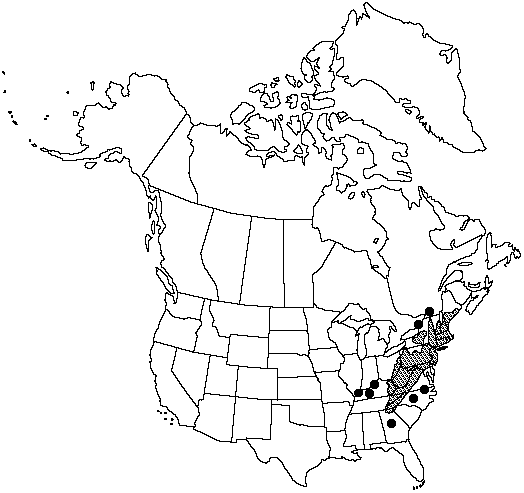Pinus rigida
Gard. Dict., ed. 8 Pinus no. 10. 1768.
Trees to 31m; trunk to 0.9m diam., straight or crooked, commonly with adventitious sprouts; crown rounded or irregular. Bark redbrown, deeply and irregularly furrowed, with long, irregularly rectangular, flat, scaly ridges, resin pockets absent. Branches arching-spreading to ascending, poorly self-pruning; 2-year-old branchlets stout (mostly over 5mm thick), orangebrown, aging darker brown, rough. Buds ovoid to ovoid-cylindric, redbrown, ca. 1–1.5cm, resinous; scale margins fringed, apex cuspidate. Leaves 3 (–5) per fascicle, spreading to ascending, persisting 2–3 years, 5–10 (–15) cm × 1–1.5 (–2) mm, straight, twisted, deep to pale yellow-green, all surfaces with fine stomatal lines, margins serrulate, apex abruptly subulate-acuminate; sheath 0.9–1.2cm, base persistent. Pollen cones cylindric, ca. 20mm, yellow. Seed-cones maturing in 2 years, shedding seeds soon thereafter or variously serotinous and long-persistent, often clustered, symmetric, conic to ovoid before opening, broadly ovoid with flat or slightly convex base when open, 3–9cm, creamy brown to light-redbrown, sessile to short-stalked, base truncate, scales firm, with dark redbrown border on adaxial surface distally; apophyses slightly raised, rhombic, with strong transverse keels; umbo central, low-triangular, with slender, downcurved prickle. Seeds broadly obliquely obovoid-deltoid; body 4–5 (–6) mm, dark-brown, mottled darker, or near black; wing 15–20mm. 2n =24.
Habitat: Upland or lowland, sterile, dry to boggy soils
Elevation: 0–1400m
Distribution

Ont., Que., Conn., Del., Ga., Ky., Maine, Md., Mass., N.H., N.J., N.Y., N.C., Ohio, Pa., R.I., S.C., Tenn., Vt., Va., W.Va.
Discussion
Pinus rigida often has poor form and is not valued highly as saw timber. It is fire successional, sprouts adventitiously, and is frequently shrubby in the northern part of its range. It is known to hybridize naturally with P. echinata.
Selected References
None.
Lower Taxa
"relatively thin" is not a number.